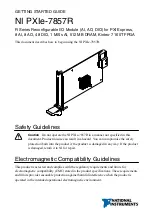
Revision C August 2014
www.trinityhighway.com
14
All rights in copyright reserved
Anchor the System
Cross-slope of assembled location shall not exceed 8% and not vary (twist more than 2%
from front to back). For these conditions, a leveling pad is required. The anchors must have
a pull out strength of 82.3 kN (18,500 lbs) and a shear strength of 109 kN (24,500 lbs).
Test Parameters
The best overall measure of anchor performance is load capacity. Anchor load capacity can
be defined by testing static tensile and static shear strengths. Static tensile strength is the
maximum force sustained by an anchor when subjected to gradual increases in loading at
the exposed end of the anchor and applied in line along its axis. Static shear strength is the
maximum force sustained by an anchor when subjected to gradual increases in loading
applied at the base of the exposed end of the anchor and applied perpendicular to its axis.
The tensile strength developed will be a function of the strength of the concrete or asphalt
surface the anchor is placed in. Embedment depth can also affect anchor tensile strength.
Tensile test of anchors chosen should be tested in compliance with ASTM E488 – Standard
Test Methods for Strength of Anchors in Concrete and Masonry Elements (see Figure 10).
Recording Test Results
Three pull tests should be conducted on site when the anchoring conditions are different
from those described in the reference section of this document with the results recorded.
Pictures of the testing should also be taken and stored with the recorded data.
The anchor surface is acceptable if the average of the three pulls is equal or greater than
82.3 kN (18,500 lbs).
Figure 10
















































